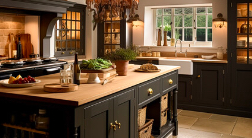 A kitchen remodel is an exciting way to increase the value of your home and improve your living space. But it’s also essential to understand what you want your end goal to be before diving in.
A kitchen remodel is an exciting way to increase the value of your home and improve your living space. But it’s also essential to understand what you want your end goal to be before diving in.
Visit kitchen showrooms and home renovation stores to observe layouts, designs, appliances, and building materials. Click https://www.kitchenremodelsandiegocal.com/ for more details.
Cabinets are the heart of any kitchen and can impact your home’s value. They’re also the most expensive part of a new kitchen, so careful consideration is necessary to avoid overspending.
The style of cabinets you choose can make a dramatic difference in your kitchen’s look and feel. Many styles are available, including modern, traditional, cottage and contemporary. You can also customize them by choosing different doors, drawer fronts and hardware.
Generally speaking, there are two types of cabinet construction: framed and frameless. Framed cabinets have a face-frame that attaches to the cabinet box, which gives them extra strength and adds an elegant appearance. Frameless cabinets do not have a face-frame and can be more sleek and contemporary in design.
Most cabinets are made of plywood or high-quality particle board for flat sections that do not need to be shaped, such as the cabinet sides and drawer bottoms. Plywood is more stable than MDF and less prone to swelling when exposed to moisture. It also holds screws and hardware better and is more durable than solid wood.
When you select your cabinets, consider the height of the cook and whether one or both people prepare meals in the kitchen. The ideal cabinet heights and drawer placement depend upon the size of the person and their dominant hand, which is influenced by the post-WWI industrial-era motion studies led by Lillian Moller Gilbreth.
You can further customize your cabinets with special features that will make them more functional and efficient. For example, pull-out spice racks, waste basket roll-outs and cutlery drawers are convenient ways to reduce the time it takes to find what you need. Other options include a lazy susan, a shelf that rotates on a central axis, which makes browsing lower cabinets easier and more comfortable.
Countertops
One of the most crucial kitchen remodel decisions involves choosing a countertop material. The choice will impact the style, durability and cost of your kitchen countertops. You will want to choose a material that complements the cabinets, ties into the style of your home and fits your lifestyle.
Granite is a popular option due to its strength and longevity. This natural stone can withstand abrasive damage and heat. It comes in a variety of colors and undertones, allowing you to find the perfect shade for your kitchen.
Quartz is a modern alternative to traditional marble and limestone. It is nonporous, meaning it does not absorb stains or odors. It also resists mold, mildew and bacteria, which makes it a hygienic choice for your kitchen. It comes in a variety of colors, designs and patterns that mimic the look of marble or other materials like wood.
Another trending kitchen countertop material is porcelain. This versatile material is durable and offers a smooth surface that is easy to clean. It is a great alternative to ceramic tile and comes in a wide range of colors and patterns that mimic the look of concrete, marble and even wood.
If you are looking for a more rustic and natural style, consider using a live edge wood slab for your kitchen countertops. This type of counter features a preserved organic shape, unique grain patterns and naturally occurring knots. It is also eco-friendly, with the ability to add warmth and contrast to any kitchen design.
Depending on the size of your kitchen and the materials you select, it may make sense to install your backsplash before installing your countertops. However, it is best to work with a contractor that can help you stay on budget during the project.
Flooring
Depending on your budget and style preferences, flooring can make or break the kitchen’s aesthetic. In addition to being functional, flooring also impacts the comfort of the space and can help reduce noise. There are many different materials to choose from, and they range in cost and durability. For example, hardwood floors are timeless and can resist dents from dropped items. However, they are more expensive and require regular refinishing. Cork and linoleum are softer on the feet, but they can be more susceptible to scratching.
Some remodelers may argue that it’s best to install cabinets first and then lay the floor. This is because it creates a smoother, cleaner finish. But others believe that laying the floor first is more practical, especially if you ever decide to change your kitchen’s layout in the future. The floors under the cabinets will need to be cut and fitted to fit your specific cabinet layout. It’s easier to do this before the cabinets are installed, and it ensures that your floors will be 100% complete.
Once the flooring is installed, it’s time for countertops, appliances, and fixtures. This step can take a while, as it’s necessary to move heavy appliances and fixtures so that they don’t ding or scratch the new flooring or cabinets.
If your kitchen’s layout needs to be modified due to structural changes (such as knocking down a wall or expanding the kitchen footprint), this can be a complicated process that requires skilled professionals. This is the most time-consuming and costly part of a kitchen remodel, but it’s vital to get it right. This is why it’s always a good idea to work with experienced contractors who understand construction, building codes, and regulations.
Lighting
Lighting is an integral component of any room, but in the kitchen it can really make or break the space. If your lighting is lacking or dated, it can completely detract from the overall design of your kitchen remodel.
There are many different types of light fixtures that can work in a kitchen, but the first step is to analyze your needs and style. Then visit kitchen showrooms and home renovation stores to get a sense of what’s available and possible.
The three key types of lighting in any kitchen are ambient, task and accent. Ambient lighting floods the space with light, allowing for visibility and creating a warm atmosphere. This can be accomplished with recessed or other overhead lighting. Task lighting illuminates specific workspaces, such as the stove, sink and counters where you prepare food. This is typically accomplished with a brighter type of lighting, like directional gimbal recessed downlighting or track lights.
Accent lighting is used to highlight certain aesthetic features of the kitchen, such as a decorative hood fan or a wine rack. This can also be done with recessed, adjustable fixtures.
Some other popular kitchen lighting ideas include under cabinet lights, pendant lights and toe kick lighting. These can illuminate areas that may not be well lit with traditional overhead fixtures, while also adding a sleek and modern look to the kitchen.
As kitchens become more of a living/gathering area for homeowners, it’s becoming common to add wall art and decorations. A great way to showcase this is with a beautiful lighted piece of artwork. Having a recessed, adjustable fixture that can highlight this artwork is a wonderful way to bring life and warmth into any kitchen.
Appliances
The kitchen appliances we select have a cascading effect on the rest of our remodel, so it’s important to make an informed decision that reflects our lifestyle and design preferences. The good news is that there’s something for everyone, from sleek and modern options to classic designs with nods to the past. And, thanks to advances in technology and manufacturing, today’s energy-efficient appliances can also elevate your design aesthetic.
Aside from making your home more comfortable and reducing utility bills, the most important consideration when choosing kitchen appliances is that they complement the rest of the space. This is especially true for refrigerators and stoves, which can add a significant amount of visual impact to the room.
Decorative lighting is another opportunity to enhance your design theme. In addition to spotlighting focal points like wall art, architectural features or plants, it can also create a sense of warmth and coziness in the kitchen. For example, hanging a chandelier over the island or dining table can create an inviting ambiance while still providing ample task lighting for cooking and eating.
Built-in appliances can also increase the monetary value of your property by adding an element of luxury to your kitchen design. And, since more and more homebuyers are seeking greener living features, incorporating energy-efficient appliances into your kitchen remodel can make it easier for you to sell your house in the future.
As a bonus, most energy-efficient appliances are engineered to operate more quietly than their standard counterparts. This helps reduce noise pollution in your home and can also be a benefit if you have young children or other family members who tend to disturb the peace.

